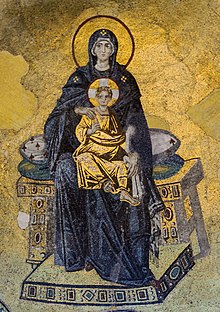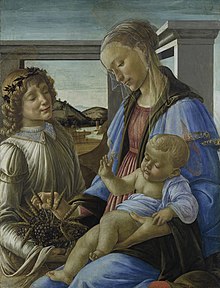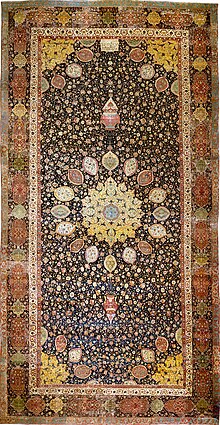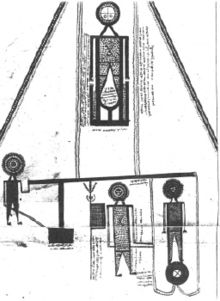How Do You Think Art Helps People to Identify With Their Religion

ninth century Byzantine mosaic of the Hagia Sophia showing the image of the Virgin and Child, ane of the starting time post-iconoclastic mosaics. It is ready against the original golden background of the sixth century
Religious fine art is artistic imagery using religious inspiration and motifs and is frequently intended to uplift the listen to the spiritual. Sacred art involves the ritual and cultic practices and applied and operative aspects of the path of the spiritual realization within the artist's religious tradition.
Buddhist art [edit]

Buddha statue in Sri Lanka.
Buddhist art originated on the Indian subcontinent following the historical life of Siddhartha Gautama, sixth to 5th century BC, and thereafter evolved by contact with other cultures equally it spread throughout Asia and the world.
Buddhist fine art followed believers as the dharma spread, adapted, and evolved in each new host country. It developed to the due north through Central Asia and into East asia to form the Northern co-operative of Buddhist art.
Buddhist fine art followed to the east as far as Southeast Asia to form the Southern branch of Buddhist art.

An example of Tibetan Buddhist fine art: Thangka Depicting Vajrabhairava, c. 1740
In Bharat, the Buddhist art flourished and even influenced the evolution of Hindu art, until Buddhism nearly disappeared in India around the 10th century due in part to the vigorous expansion of Islam alongside Hinduism.
Tibetan Buddhist art [edit]
Most Tibetan Buddhist artforms are related to the practice of Vajrayana or Buddhist tantra. Tibetan art includes thangkas and mandalas, often including depictions of Buddhas and bodhisattvas. Cosmos of Buddhist art is usually done as a meditation equally well as creating an object as aid to meditation. An instance of this is the cosmos of a sand mandala by monks; before and after the construction prayers are recited, and the form of the mandala represents the pure environs (palace) of a Buddha on which is meditated to train the listen. The piece of work is rarely, if ever, signed by the artist. Other Tibetan Buddhist art includes metal ritual objects, such as the vajra and the phurba.
Indian Buddhist fine art [edit]
Two places propose more vividly than any others the vitality of Buddhist cave painting from about the fifth century Ad. One is Ajanta, a site in India long forgotten until discovered in 1817. The other is Dunhuang, one of the great oasis staging posts on the Silk Road...The paintings range from calm devotional images of the Buddha to lively and crowded scenes, often featuring the seductively total-breasted and narrow-waisted women more than familiar in Indian sculpture than in painting.[1]
Christian art [edit]
Christian sacred art is produced in an attempt to illustrate, supplement and portray in tangible class the principles of Christianity, though other definitions are possible. Information technology is to brand imagery of the different beliefs in the world and what it looks like. Near Christian groups employ or have used fine art to some extent, although some have had potent objections to some forms of religious image, and there have been major periods of iconoclasm within Christianity.
Nearly Christian art is allusive, or built around themes familiar to the intended observer. Images of Jesus and narrative scenes from the Life of Christ are the most common subjects, especially the images of Christ on the Cross.
Scenes from the Old Testament play a part in the art of virtually Christian denominations. Images of the Virgin Mary, belongings the baby Jesus, and images of saints are much rarer in Protestant art than that of Roman Catholicism and Eastern Orthodoxy.
For the do good of the illiterate, an elaborate iconographic system developed to conclusively identify scenes. For example, Saint Agnes depicted with a lamb, Saint Peter with keys, Saint Patrick with a shamrock. Each saint holds or is associated with attributes and symbols in sacred art.
History [edit]

Virgin and Child. Wall painting from the early catacombs, Rome, 4th century.
Early Christian art survives from dates near the origins of Christianity. The oldest surviving Christian paintings are from the site at Megiddo, dated to effectually the year 70, and the oldest Christian sculptures are from sarcophagi, dating to the beginning of the 2nd century. Until the adoption of Christianity past Constantine Christian fine art derived its mode and much of its iconography from popular Roman art, but from this point grand Christian buildings built nether imperial patronage brought a demand for Christian versions of Roman elite and official art, of which mosaics in churches in Rome are the about prominent surviving examples.
During the development of early Christian art in the Byzantine empire (see Byzantine fine art), a more than abstruse aesthetic replaced the naturalism previously established in Hellenistic art. This new manner was hieratic, meaning its primary purpose was to convey religious significant rather than accurately render objects and people. Realistic perspective, proportions, light and color were ignored in favour of geometric simplification of forms, reverse perspective and standardized conventions to portray individuals and events. The controversy over the use of graven images, the estimation of the Second Commandment, and the crisis of Byzantine Iconoclasm led to a standardization of religious imagery within the Eastern Orthodoxy.

The Renaissance saw an increment in monumental secular works, just until the Protestant Reformation Christian art continued to exist produced in cracking quantities, both for churches and clergy and for the laity. During this time, Michelangelo Buonarroti painted the Sistine Chapel and carved the famous Pietà, Gianlorenzo Bernini created the massive columns in St. Peter's Basilica, and Leonardo da Vinci painted the Last Supper. The Reformation had a huge upshot on Christian art, rapidly bringing the production of public Christian art to a virtual halt in Protestant countries, and causing the destruction of about of the art that already existed.
As a secular, non-sectarian, universal notion of fine art arose in 19th-century Western Europe, secular artists occasionally treated Christian themes (Bouguereau, Manet). Only rarely was a Christian artist included in the historical canon (such equally Rouault or Stanley Spencer). Nevertheless many modernistic artists such equally Eric Gill, Marc Chagall, Henri Matisse, Jacob Epstein, Elisabeth Frink and Graham Sutherland have produced well-known works of art for churches.[two] Through a social estimation of Christianity, Fritz von Uhde as well revived the interest in sacred art, through the delineation of Jesus in ordinary places in life.
Since the appearance of printing, the sale of reproductions of pious works has been a major element of popular Christian culture. In the 19th century, this included genre painters such as Mihály Munkácsy. The invention of colour lithography led to broad circulation of holy cards. In the modern era, companies specializing in modern commercial Christian artists such as Thomas Blackshear and Thomas Kinkade, although widely regarded in the fine art globe as kitsch,[3] take been very successful.
The terminal part of the 20th and the offset part of the 21st century have seen a focused effort past artists who claim religion in Christ to re-establish art with themes that revolve around faith, Christ, God, the Church, the Bible and other archetype Christian themes as worthy of respect by the secular art world. Artists such as Makoto Fujimura take had significant influence both in sacred and secular arts. Other notable artists include Larry D. Alexander, Gary P. Bergel, Carlos Cazares, Bruce Herman, Deborah Sokolove, and John August Swanson.[4]
Confucian art [edit]
Confucian art is fine art inspired by the writings of Confucius, and Confucian teachings. Confucian art originated in China, so spread westwards on the Silk road, southward down to southern China and then onto Southeast Asia, and eastwards through northern China on to Japan and Korea. While it notwithstanding maintains a strong influence within Indonesia, Confucian influence on western fine art has been limited. While Confucian themes enjoyed representation in Chinese fine art centers, they are fewer in comparison to the number of artworks that are about or influenced by Daoism and Buddhism.[five]
Hindu art [edit]
Hinduism, with its 1 billion followers, it makes up nearly xv% of the earth's population and as such the culture that ensues it is full of different aspects of life that are effected by art. There are 64 traditional arts that are followed that start with the classics of music and range all the style to the application and adornment of jewellery. Since religion and culture are inseparable with Hinduism recurring symbols such as the gods and their reincarnations, the lotus flower, extra limbs, and even the traditional arts make their appearances in many sculptures, paintings, music, and dance.
Islamic art [edit]

A specimen of Islamic sacred art: in the Great Mosque of Kairouan in Tunisia, the upper office of the mihrab (prayer niche) is decorated with ninth-century lusterware tiles and painted intertwined vegetal motifs.
A prohibition confronting depicting representational images in religious art, besides as the naturally decorative nature of Arabic script, led to the apply of calligraphic decorations, which usually involved repeating geometrical patterns and vegetal forms (arabesques) that expressed ideals of society and nature. These were used on religious architecture, carpets, and handwritten documents.[6] Islamic art has reflected this counterbalanced, harmonious world-view. It focuses on spiritual essence rather than physical class.
While there has been an aversion to potential idol worship through Islamic history, this is a distinctly modern Sunni view. Farsi miniatures, forth with medieval depictions of Muhammad and angels in Islam, stand as prominent examples opposite to the modernistic Sunni tradition. Also, Shi'a Muslims are much less averse to the depiction of figures, including the Prophet's as long every bit the depiction is respectful.
Figure representation [edit]
The Islamic resistance to the representation of living beings ultimately stems from the belief that the cosmos of living forms is unique to God. It is for this reason that the role of images and image makers has been controversial.
The strongest statements on the bailiwick of figural depiction are made in the Hadith (Traditions of the Prophet), where painters are challenged to "breathe life" into their creations and threatened with punishment on the Twenty-four hours of Judgment.

The Qur'an is less specific just condemns idolatry and uses the Standard arabic term musawwir ("maker of forms", or creative person) as an epithet for God. Partially equally a result of this religious sentiment, figures in painting were often stylized and, in some cases, the destruction of figurative artworks occurred. Iconoclasm was previously known in the Byzantine period and aniconicism was a feature of the Judaic earth, thus placing the Islamic objection to figurative representations within a larger context. As ornamentation, however, figures were largely devoid of any larger significance and perhaps therefore posed less challenge.[7] Every bit with other forms of Islamic ornament, artists freely adapted and stylized bones human being and animate being forms, giving ascent to a swell variety of figural-based designs.
Arabesque [edit]
| | This section is empty. You can assistance by adding to information technology. (Oct 2018) |
Calligraphy [edit]
Calligraphy is a highly regarded element of Islamic art. The Qur'an was transmitted in Arabic, and inherent within the Arabic script is the potential for ornamental forms. The employment of calligraphy equally ornament had a definite artful entreatment only often also included an underlying talismanic component. While almost works of fine art had legible inscriptions, non all Muslims would have been able to read them. One should always keep in mind, however, that calligraphy is principally a means to transmit a text, albeit in a decorative form.[8] From its elementary and primitive early examples of the 5th and 6th century AD, the Arabic alphabet developed rapidly after the rise of Islam in the 7th century into a beautiful form of fine art. The main two families of calligraphic styles were the dry styles, called generally the Kufic, and the soft cursive styles, which include Naskhi, Thuluth, Nastaliq and many others.[9]
Geometry [edit]
Geometric patterns brand upwards i of the three nonfigural types of ornament in Islamic fine art. Whether isolated or used in combination with nonfigural ornamentation or figural representation, geometric patterns are popularly associated with Islamic art, largely due to their aniconic quality. These abstract designs not only adorn the surfaces of awe-inspiring Islamic compages just also part as the major decorative element on a vast array of objects of all types.[10]
Jain art [edit]
Jain art refers to religious works of art associated with Jainism. Even though Jainism spread only in some parts of India, information technology has made a pregnant contribution to Indian fine art and architecture.[eleven]
Mandaean art [edit]

Mandaean art can be establish in illustrated manuscript scrolls called diwan. Mandaean scroll illustrations, usually labeled with lengthy written explanations, typically contain abstract geometric drawings of uthras that are reminiscent of cubism or prehistoric stone art.[12]
Sikh art [edit]
The art, culture, identity and societies of the Sikhs has been merged with different locality and ethnicity of different Sikhs into categories such as 'Agrahari Sikhs', 'Dakhni Sikhs' and 'Assamese Sikhs'; however there has emerged a niche cultural miracle that can be described as 'Political Sikh'. The art of diaspora Sikhs such as Amarjeet Kaur Nandhra,[13] and Amrit and Rabindra Kaur Singh (The Singh Twins),[14] is partly informed by their Sikh spirituality and influence.
Taoist fine art [edit]
Taoist fine art (as well spelled as Daoist fine art) relates to the Taoist philosophy and narratives of Lao-tzu (also spelled as Laozi) that promote "living simply and honestly and in harmony with nature."[15]
See likewise [edit]
- Religious image
- Spiritualist art
References [edit]
- ^ "History Of Buddhism". Historyworld.net. Retrieved 2013-09-06 .
- ^ Beth Williamson, Christian Fine art: A Very Short Introduction, Oxford University Printing (2004), page 110.
- ^ Cynthia A. Freeland, But Is It Art?: An Introduction to Fine art Theory, Oxford Academy Press (2001), page 95
- ^ Buenconsejo, Clara (21 May 2015). "Contemporary Religious Art". Mozaico. Archived from the original on 29 September 2015. Retrieved 2 June 2015.
- ^ Karetzky, Patricia (2014). Chinese Religious Art. Lanham, MD: Lexington Books. p. 127. ISBN9780739180587.
- ^ "Islamic Fine art – Islamic Fine art of Calligraphy and Arabesque". Archived from the original on 2004-02-18. Retrieved 2014-02-eleven .
- ^ "Figural Representation in Islamic Art | Thematic Essay | Heilbrunn Timeline of Art History". Metropolitan Museum of Art. Retrieved 2013-09-06 .
- ^ "Calligraphy in Islamic Art | Thematic Essay | Heilbrunn Timeline of Art History". Metropolitan Museum of Art. Retrieved 2013-09-06 .
- ^ "Art of Arabic Calligraphy". Sakkal. Retrieved 2013-09-06 .
- ^ "Geometric Patterns in Islamic Art | Thematic Essay | Heilbrunn Timeline of Art History | The Metropolitan Museum of Art". Metmuseum.org. Retrieved 2013-09-06 .
- ^ Kumar 2001, p. 1. sfn mistake: no target: CITEREFKumar2001 (help)
- ^ Nasoraia, Brikha H.S. (2021). The Mandaean gnostic religion: worship practice and deep thought. New Delhi: Sterling. ISBN978-81-950824-1-4. OCLC 1272858968.
- ^ Material creative person Amarjeet Kaur Nandhra
- ^ Singh Twins Art Launches Liverpool Fest
- ^ Augustin, Birgitta. "Daoism and Daoist Art." In Heilbrunn Timeline of Art History. New York: The Metropolitan Museum of Art, 2000–. http://www.metmuseum.org/toah/hd/daoi/hd_daoi.htm (December 2011)
Further reading [edit]
- Evans, Helen C.; Wixom, William D. (1997). The glory of Byzantium: art and culture of the Heart Byzantine era, A.D. 843–1261 . New York: The Metropolitan Museum of Art. ISBN978-0-8109-6507-ii.
- Hein, David. "Christianity and the Arts." The Living Church, May 4, 2014, eight–11.
- The Vatican: spirit and fine art of Christian Rome . New York: The Metropolitan Museum of Fine art. 1982. ISBN978-0-87099-348-0.
- Morgan, David (1998). Visual Piety: A History and Theory of Popular Religious Images. Berkeley, CA: University of California Press.
- Sauchelli, Andrea (2016). The Will to Make‐Believe: Religious Fictionalism, Religious Behavior, and the Value of Art. Philosophy and Phenomenological Research, 93, 3.
- Charlene Spretnak, The Spiritual Dynamic in Modern Art : Art History Reconsidered, 1800 to the Present.
- Veith, Gene Edward, junior. The Gift of Art: the Identify of the Arts in Scripture. Downers Grove, Ill.: Inter-Varsity Printing, 1983. 130 p. ISBN 978-0-87784-813-4
External links [edit]
Source: https://en.wikipedia.org/wiki/Religious_art
0 Response to "How Do You Think Art Helps People to Identify With Their Religion"
Post a Comment